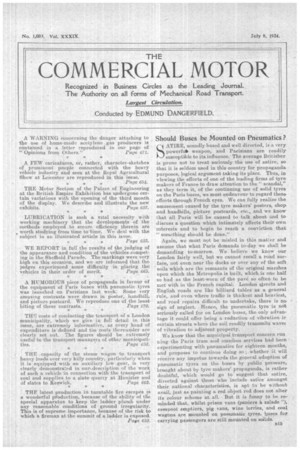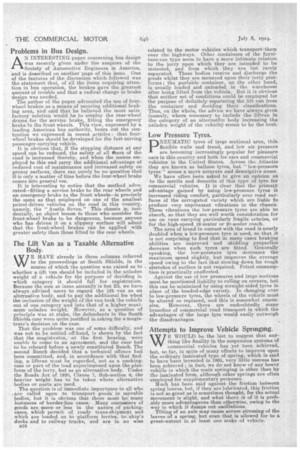Should Buses be Mounted on Pneumatics ? s
Page 1

Page 2

If you've noticed an error in this article please click here to report it so we can fix it.
• 1 ATIRE, soundly based and well directed, is a very powerful, weapon, and Parisians are readily
Should Buses be Mounted on Pneumatics ? s
• 1 ATIRE, soundly based and well directed, is a very powerful, weapon, and Parisians are readily susceptible to its influence. The average Britisher is prone not to treat seriously the use of satire, so that it is seldom used in this country for propaganda purposes, logical argument taking its place. Thus, in viewing the efforts of one of the leading firms of tyre makers of France to draw attention to the " scandal," as they term it, of the continuing use of solid tyres on the Paris buses, we must endeavour to regard these efforts through French eyes. We can fully realize the amusement caused by the tyre makers' posters, shop and handbills, picture postcards, etc., and we know that all Paris will be caused to talk about and to discuss a:question which intimately affects their own interests and to begin to reach a conviction that "something should be done."
Again, we must not be misled in this matLer and assume that what Paris demands to-day we shall be demanding to-morrow. We believe we know our London fairly well, but we cannot recall a road surface, not even near the docks or over any of the soft soils which are the remnants of the original marshes upon which the Metropolis is built, which is one half so bad as the least-worn of the pave so often to be met with in the French capital. London greets and English roads are like billiard tables as a general rule, and even where traffic is thickest and heaviest, and road repairs difficult to undertake, there is no sign of neglect. Hence, the pneumatic tyre is not seriously called for on London buses, the only advantage it could offer being a reduction of vibration ir certain streets viler° the soil readily transmits waves of vibration to adjaeent property.
We know that the municipal transport concern run fling the Paris tram and omnibus services had been experimenting with pneumatics for eighteen months, and proposes to continue doing so ; whether it will receive any impetus towards the general adoption of pneumatic tyres on the buses by public pressure, brought about by tyre makers' propaganda, is rather doubtful, which would go to suggest that satire, directed against those who include satire amongst their national characteristics, is apt to be without avail, just as painting a red object red does not alter its colour scheme at. all. But it is funny to be reminded that, whilst prison vans (paniers it salade "), cesspool emptiers, pig vans, wine lorries, and coal wagons are mounted on pneumatic tyres, biases for carrying passengers are still mounted on solids.
Problems in Bus Design.
AN INTERESTING paper concerning bus design was recently given nuder the auspices of the Society of Automotive Engineers in America, and is deaeribed on another page of this issue. One of the features of the discussion which followed was the statement that, of all the items requiring attention in bus operation, the brakes gave the greatest amount of trouble and that a radical change in brake design was needed. The author of the paper advocated the use of fourwheel brakes as a means of securing additional braking area, and said that he believed the most satisfactory solution would be to employ the rear-wheel drums for the service brake, fitting the emergency brake to the front wheels. This view, expressed by a leading American bus authority, bears out the contention we expressed in recent articles : that fourwheel brakes should be developed for the fast-moving passenger-carrying vehicle. It is obvious that, if the stopping distance at any speed can be reduced, the 'safety of all users of the road is increased thereby, and when the means employed to this end carry the additional advantage of reduced cost of maintenance and increased safety on greasy surfaces, there can surely be no question that it is only a matter of time before the four-wheel brake comes into general use. . It is interesting to notice that the method advocated—fitting a service brake to the rear wheels and an emergency brake to the front wheels—is precisely the same as that employed on one of the smallest petrol driven vehicles on the road in this country, namely, the "Austin Seven." This chassis is, incidentally, an object lesson to those who consider the front-wheel brake to be dangerous, because anyone who has driven it on a slippery surface will admit that the front-wheel brakes can be applied with greater safety than those fitted to the rear wheels.
The Lift Van as a Taxable Alternative Body.
E HAVE already in these columns referred to the proceedings at South Shields, in the course of which the question was raised as to whether a lift van should be included in the unladen weight of a vehicle for the purpose of deciding in which category it should fall for registration. Because the sum at issue annually is but 12, we have always advised users to regard the lift van as an alternative body, and to pay the additional fee when the inclusion of the weight of the van took the vehicle out of one category and into that of a higher maximum unladen weight. However, as a question of principle was at stake, the defendants in the South Shields rase were quite justified in asking for a magistrate's decision on the case. That the problem was one of some difficulty, and was not to be settled off-hand, is shown by the fact that the magistrates, at the first hearing, were unable to come to an agreement, and the case • had to be reheard before a newly constituted Bench. The second Bench decided that a technical offence had been. committed, and, in accordance with that finding, a liftvan must be regarded, not as a packingCase or part of the load superimposed upon the platform of the lorry, but as an alternative body. Under the Roads Act of 1920, Clause 7, Sub-section 6, the heavier weight has to be taken where alternative bodies or parts are used.
The question is of immediate importance to all who .are called upon to transport goods in movable bodies, but it is obvious that there must be many instances of border-line eases.Many containers of goods are more or less in the nature of packingcases, which permit of ready trans-shipment and which are loaded on to platform lorries, to ship's decks-and to railway trucks, and are in no wise a16
related to the motor vehicles which transport 'them over the' highways. Other containers, of the furniture-van type seem to have a more intimate relation to the lorry upon which they are intended to be mounted, and from which they are but rarely separated. These bodies receive and discharge the goods whilst they are mounted upon their lorry platforms ; the portable container, on the other hand, is usually loaded and unloaded in the warehouse after being lifted from the vehicle. But it is obvious that neither set a conditions could be employed for the purpose of definitely separating the lift van from the container and deciding their classifications. Thus, on the whole, the advice we have always given (namely, where necessary to include the liftvan in the category of an alternathe body increasing the unladen weight of the vehicle) seems to be the best.
Low Pressure Tyres.
pNEUMATIC tyres of large sectional area, thin flexible walls and tread, and low air pressure are becoming increasingly popular for pleasure ears in this country and both for cars and commercial vehicles in the United States. Across the Atlantic they are known as balloon tyres, but "low-pressure tyres " seems a more accurate and descriptive name. We have often been asked to give an opinion as to the merits and demerits of this type of tyre for commercial vehicles. It is clear that the primary advantage .gained by using low-pressure tyres is increased riding comfort, particularly over road surfaces of the corrugated variety which are liable to produce very unpleasant vibrations in the chassis. These vibrations the low-pressure tyres are able to absorb, so that they are well worth consideration for use on vans carrying particularly fragile articles, or for the high-speed 16-seater or 20-seater coach. The area of tread in contact with the road is nearly doubled when a low-pressure tyre is used, so that it is not surprising to find that in many cases braking abilities are improved and skidding properfies decrease when such tyres are fitted. Generally spea,king, the low-pressure tyre decreases the maximum speed slightly, but improves the average speed owing to the fact that slowing down for rough stretches of surface is not required. Petrol consumption is practically unaffected. Against the use of low pressures and large sections must be mentioned liability to rolling on corners, but this can be minimized by using straight-sided tyres in place of the beaded-edge variety. In changing over to low-pressure tyres, the wheels of the vehicle must be altered or replaced, and this is somewhat expensive. However, there are undoubtedly many branches of commercial road transport in which the advantages of the large tyre would easily outweigh the disadvantages.
Attempts to Improve Vehicle Springing.
WE WOULD be the last to suggest that anything like finality in the suspension systems of commercial vehicles has yet been achieved, but, so far, in spite of many efforts to improve upon the ordinary laminated type of spring, which is said to have been invented in 1665, very little success has been achieved; in fact, we do not know of any heavy vehieIe in which the main springing is other than by the laminated form, although other springs are often employed for supplementary purposes. Much has been said against the friction between spring leaves, but, if they are lubricated, this friction is not so great as is sometimes thought, for the actual movement is slight, and what there is of it is probably more advantageous than otherwise, owing to the way in which it damps out oscillations. Tilting of an axle may cause severe stressing of the leaves of a spring, but even that is allowed for to a great-extent in at least. one make of vehicle.






























